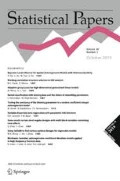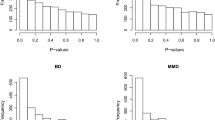Abstract
We present tests of multivariate uniformity using data depth, the normal quantiles and the interpoint distances between the observations. We investigate the properties of the interpoint distances among uniform random vectors. We compare the performance of the proposed tests with two existing statistics under the hypothesis of uniformity and obtain their empirical power under various alternatives in a Monte Carlo study.
Similar content being viewed by others
References
Anderson TW (2003) An introduction to multivariate statistical analysis. Wiley-Interscience, Hoboken
Arcones MA, Giné E (1993) Limit theorems for u-processes. Ann Probab 21:1494–1542
Avram F, Bertsimas D (1992) The minimum spanning tree constant in geometrical probability and under the independent model: a unified approach. Ann Appl Probab 2:113–130
Barrow J, Bhavsar S, Sonoda D (1985) Minimal spanning trees, filaments and galaxy clustering. R Astron Soc Mon Not 216:17–35
Berrendero JR, Cuevas A, Vázquez-Grande F (2006) Testing multivariate uniformity: the distance-to-boundary method. Can J Stat 34:693–707
Cuesta-Albertos JA, Nieto-Reyes A (2008) The random Tukey depth. J Comput Stat Data Anal 52:4979–4988
Elmore RT, Hettmansperger TP, Xuan F (2006) Spherical data depth and a multivariate median. In: Liu RY, R Serfling, DL Souvaine (eds) Proceedings of data depth: robust multivariate analysis, computational geometry and applications. American Mathematical Society, Rhode Island, pp 87–101
Green JR, Hegazy YA (1976) Powerful modified-EDF goodness-of-fit tests. J Am Stat Assoc 71:204–209
Hegazy YAS, Green JR (1975) Some new goodness-of-fit tests using order statistics. J R Stat Soc 24:299–308
Jammalamadaka SR, Janson S (1986) Limit theorems for a triangular scheme of U-statistics with applications to inter-point distances. Ann Probab 14:1347–1358
Joe H (1997) Multivariate models and dependence concepts. Chapman & Hall, New York
Krumbholz W, Schmid F (1996) A non standard \(\chi ^2\) test of fit for testing uniformity with unknown limits. Stat Pap 37(4):365–373
Lange T, Mosler K, Mozharovskyi P (2014) DD-classification of asymmetric and fat-tailed data. In: Spiliopoulou M, Schmidt-Thieme L, Janning R (eds) Data analysis. Machine learning and knowledge discovery. Springer, Berlin, pp 71–78
Lee S (1999) The central limit theorem for Euclidean minimal spanning trees ii. Adv Appl Probab 31:969–984
Li J, Liu RY (2008) Multivariate spacings based on data depth. I. Construction of nonparametric multivariate tolerance regions. Ann Stat 36:1299–1323
Liu RY (1990) On a notion of data depth based on random simplices. Ann Stat 18:405–414
Liu RY, Parelius JM, Singh K (1999) Multivariate analysis by data depth: descriptive statistics, graphics and inference. Ann Stat 27:783–858
Liu Z, Modarres R (2011) Lens data depth and median. J Nonparametr Stat 23:1063–1074
Marsaglia G (1968) Random numbers fall mainly in the planes. Proc Natl Acad Sci 61:25–28
Modarres R (2014) On the interpoint distances of Bernoulli vectors. Stat Probab Lett 84:215–222
Mosler K (2002) Multivariate dispersion, central regions and depth: the lift zonoid approach. Springer, New York
Mozharovskyi P, Mosler K, Lange T (2014) Classifying real-world data with the DD-procedure. Adv Data Anal Classif 9:287–314 (Springer online-first)
Nelson RB (2006) An introduction to copulas, 2nd edn. Springer, New York
Pardo MC (2003) A test for uniformity based on informational energy. Stat Pap 44(4):521–534
Petrie A, Willemain TR (2013) An empirical study of tests for uniformity in multidimensional data. Comput Stat Data Anal 64:253–268
Rosenblatt M (1952) Remarks on multivariate transformation. Ann Math Stat 23:470–472
Schellhaas H (1999) A modified Kolmogorov–Smirnov test for a rectangular distribution with unknown parameters: computation of the distribution of the test statistic. Stat Pap 40(3):343–349
Steele J (1988) Growth rates of Euclidean minimal spanning trees with power-weighted edges. Ann Probab 16:1767–1787
Stephens MA (1986) Test for the uniform distribution. In: D’Agostino RB, Stephens MA (eds) Goodness-of-fit techniques. Marcel Dekker, Inc, New York, pp 331–336
Stuart A, Ord K (1994) Kendall’s advanced theory of statistics, distribution theory, vol 1, 6th edn. Oxford University Press, New York
Tukey JW (1975) Mathematics and picturing data. In: James RD (ed) Proceedings of the international congress on mathematics. Canadian Mathematical Congress, Montreal, pp 523–531
Wiegand T, Moloney K (2004) Rings, circles, and null-models for point pattern analysis in ecology. OIKOS 104:209–229
Zuo Y, Serfling R (2000) General notions of statistical depth function. Ann Stat 28:461–482
Acknowledgments
The authors would like to thank two anonymous referees and the Editor for comments that led to an improved manuscript.
Author information
Authors and Affiliations
Corresponding author
Appendix
Appendix
Proof for Theorem 1
Let \(e^2_{i, j}=\Vert \mathbf {u}_i - \mathbf {u}_j\Vert ^2\). Consider
and
From Eq. 9, we have
Let \(\epsilon _{ijkh}=(u_{i,j}-u_{k,h})\). One observes,
Furthermore,
and
One can verify that
Similarly,
It follows from Eqs. 10 to 15,
The covariance term in Eq. 9 can be expanded as
One can verify
One observes,
where \(E[\epsilon _{1131}^2\epsilon _{1121}^4]=\frac{19}{1260}\). Similarly,
where \(E[\epsilon _{1131}^2\epsilon _{1121}^2]=\frac{1}{30}.\) It follows from Eqs. 18 to 20 that
One can also verify
Consider the first term in Eq. 22. One observes
Similarly,
by symmetry. Consider the last term in Eq. 22. One observes
Equation 17 becomes
and
Rights and permissions
About this article
Cite this article
Yang, M., Modarres, R. Multivariate tests of uniformity. Stat Papers 58, 627–639 (2017). https://doi.org/10.1007/s00362-015-0715-x
Received:
Revised:
Published:
Issue Date:
DOI: https://doi.org/10.1007/s00362-015-0715-x



